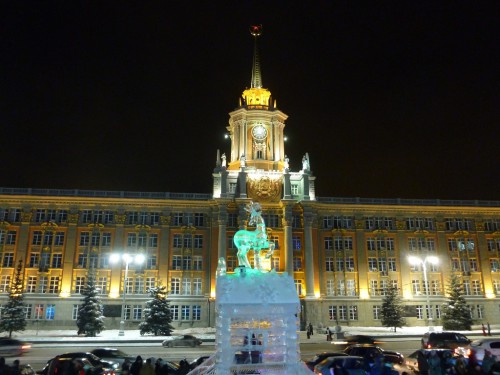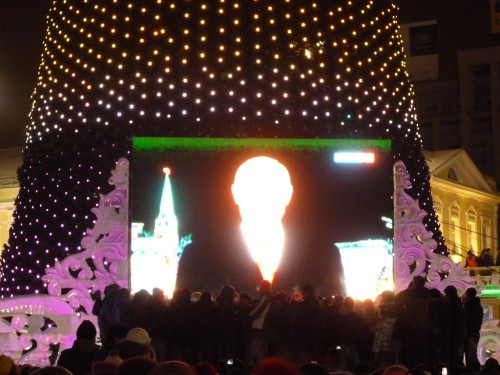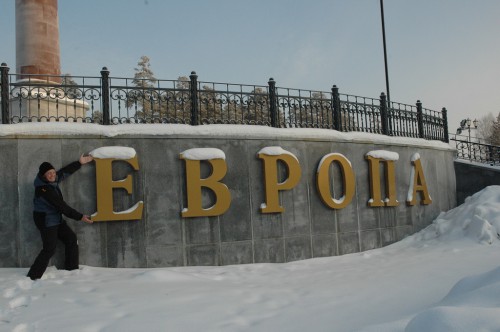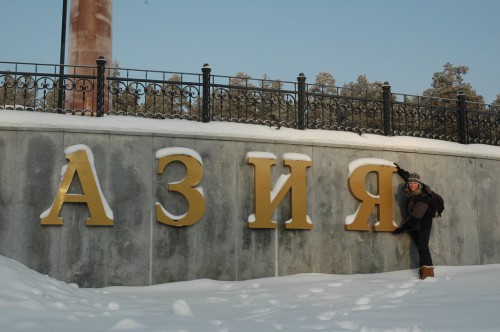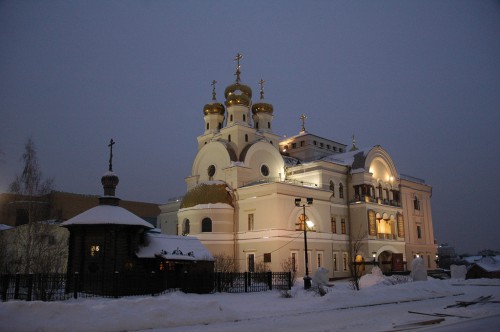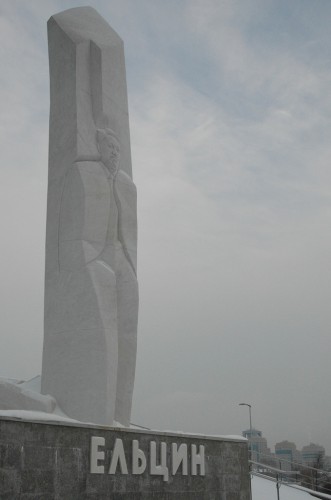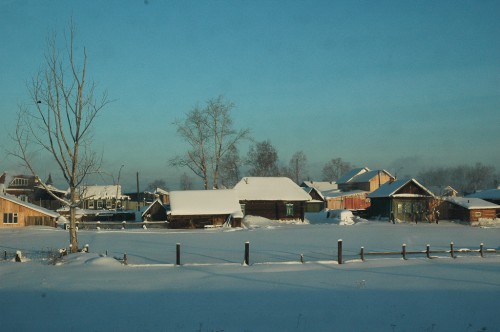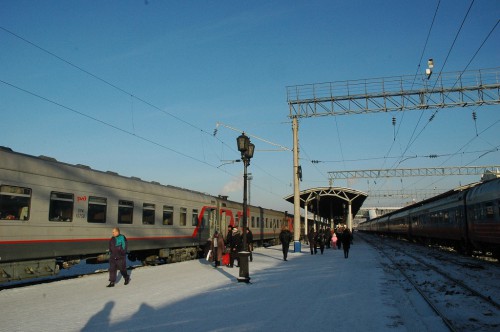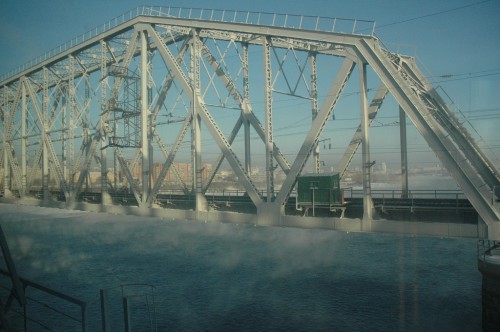Our first stop on our journey from Moscow to Beijing by train was Yekaterinburg. Our fellow travelers on the train asked us what reason there was to stop in Yeksterinburg, they werenâEURTMt aware of anything interesting. However the city itself has a few things to offer and an important attraction for us is located just outside this city in the Ural Mountains.
When we left the train right on time at 8:32pm we were surprised mostly by one thing: the freezing temperature. While we had the information from before leaving Moscow that the thermometer stood at -7 degrees Celsius, the temperature had dropped to -17 in the previous 24 hours. We could feel this difference immediately with our first steps since a cold wind blew into our faces. Fortunately we had a room reserved in the Marins Park Hotel, which is located directly opposite the train station.
For a hotel which intends to be a decent conference hotel (at least according to our guidebook), the rooms were rather simple and old and there werenâEURTMt even any non-smoking rooms, just more or less smoky rooms. Although quite used, our room ended up being clean, we slept well and had warm water to shower.
Once we had settled in the hotel and taken a shower, there were two topics to be addressed: where does Yekterinburg celebrate New Year and where could we get some food around this time of day. The nice lady at the reception desk recommended to head out to the square of the year 1905. She indicated that it was no problem to walk there since it was only a 30 minute walk and the temperature wasnâEURTMt too bad. Us being terrible cowards we decided to take the subway for two stops and were hoping to find something to eat in the city center.
We were positively surprised to find a square full of ice sculptures, a small fair with a few sales and food stalls and quite a few people. During the time until midnight we tried to chase down some food in the streets surrounding the square but to no avail. All restaurants were closed. Finally we settled on a small snack from one of the food stalls on the square. Eventually the people moved in front of the video screen to listen to the presidentâEURTMs speech and to count-down the remaining seconds of 2012. It seemed that the people were really interested in hearing what he had so say. Or was that they were just waiting for the count-down?
Finally 2012 was over and the New Year began. For Lenka and I there were a number of firsts this year: it was the first time we ever celebrated New Year together. It was also our first time in Russia and Yekaterinburg in particular. Finally we were on the Easten edge of the Ural Mountains and thus it was the first time Lenka celebrate New Year in Asia.
The crowd disappeared rather quickly and so did we. Since we were tired from our recent train ride, we headed back to the hotel for a good nightâEURTMs sleep.
For the first day in 2013 we had a seemingly simple plan: find the monument which symbolizes the border between Asia and Europe. According to our guidebook we had a couple of selections to choose from. There are at least two monuments, a historical one and a more modern one a little bit more accessible. We decided to opt for the historical place which is located approximately 40km West of Yekaterinburg. The information we had was that we had to take a bus or taxi to Pervouralsk and it should only be 2km from there. Unfortunately Pervouralsk is a city of more than 100000 inhabitants and we had no idea where we had to get off the bus nor which direction we had to walk.
Pervouralsk is served by frequent bus connection from the Northern bus station in Yekaterinburg, located right next to the train station. We caught the bus to Pervouralsk and hoped to find some hint there on how to get to the monument. Unfortunately there was no indication of the whereabouts of this monument. A sales lady explained that the monument was about 15km from the bus station and that it could be reached by bus line 103. The lady at the ticket counter however let us know that the bus 103 would only run the next day. The sales lady came up with an alternative plan which included city bus line 4. She pointed in a direction and off we went.
Once we reached a bus stop, we asked the only person there about the border between Europe and Asia. He again pointed in a direction in which we walked, past a gas station up to a point where we thought that the path would lead nowhere. We returned to the gas station and started querying the clerk. She had a rough idea of where we wanted to go, but fortunately a customer walked in and knew exactly where we wanted to go and how to get there. He even offered us a ride for part of the way. Happily we accepted his offer and he brought us back to where we were before and even a little farther. He pointed out where exactly we had to walk and where we had to turn. We politely said goodbye and wished him a happy new year (spassiba, s novim godom).
Once more we asked for the way at a Methane station, where we were greeted by a young fellow who seemed to be happy to be able to talk to somebody. Happily he explained that we had to follow the road for another 1.5km and that we would see a bolshoi complex (big monument) on the left hand side, which would represent the border between Europe and Asia.
About 15 minutes later we had finally made it! We had reached the official border between Europe and Asia. Besides the historic rock from the 19th century, the Russian built a huge pillar indicating this geographical border. The local population seems to like the place since we saw unmistakable traces of festive activities of the previous night.
After taking of few pictures we headed back to Yekaterinburg. Since we had passed several bus stops during our search for the monument, we now knew where the closest stop for the bus to Yekaterinburg was.
Finding dinner that night again was more difficult, although a few restaurants were open compared to the previous night. Unfortunately the open restaurants were all foreign, such as Japanese sushi places, Italian pizzerias and American fast food. The place where we wanted to try Russian pirogi unfortunately was still closed, thus we ended up in T.G.I. FridayâEURTMs. However we enjoyed some delicious hot chocolate in the Schokoladnitsa next door afterwards. Cafes which also serve light food seem to be very trendy and are almost omnipresent in Russia. Starbucks is also present, however the local competition is very stiff.
During our second day in Yekaterinburg we visited the sights in and around the city center. Two things which played a huge role in Russian history could not be missed: firstly the murder on the Romanov family was definitely the end of the Tsars in Russia and secondly the first president of âEURoedemocraticâEUR Russia, Boris Yeltsin, was from Yekterinburg. For the latter they built a nice monument on the side of the street in his honor. One detail we remember from Yeltsin however was missing: the red nose.
During our walk through the city we saw many historic buildings and monuments. From the museums we chose to visit the Metenkov-House. We expected to find an extensive collection of photographs of historic Yekaterinburg. Tucked away in one corner of the museum there were a few such pictures which displayed the work of the photographer Metenkov during the past century. The main exhibit however were animal pictures taken by various Russian and a few international photographers.
Before stopping by Shtolle, the pirogi restaurant which had been closed the previous day, we visited the place where Tsar Nikolai II, his wife and his 4 children were murdered in 1918. A documentary which I saw during the flight from Beijing to Moscow had been a great introduction. The house were the Romanov family had spent their last days was torn down 1977 on the command of a certain Boris Yeltsin. His goal was to avoid that the site mignt become a gathering place for revolutionists. Unfortunately one could only visit the museum on a guided tour which was held in Russian.
Due to our high interest in current day Russian food was much higher at that point than our interest in the Russian past, we headed for the pirogi restaurant. The selection looked amazing and we were looking forward to a delicious meal. We got the delicious meal, however the selection was naturally limited due to the fact that only one type of salty pirogi was still available and one piece of apple was left besides cranberry pirogi. We still enjoyed the excellent food and well stuffed headed off.
To get ready for the following two and a half days on the train, we went on a shopping tour for some food. It was not an easy feat to find suitable food in good quality. YekaterinenburgâEURTMs supermarkets were father small and only had very little fresh produce to offer. Our expectations were not adjusted to the central Russian reality. However, adding the products of three different supermarkets we ended up having an emergency stock of food which we planned to extend through food from the platforms and the dining car.
On time, at 9:51pm, the train 350 from Moscow to Blagoevshchensk arrived in Yekaterinburg. The provodnitsa unfortunately didnâEURTMt really know what to make of our e-tickets, however let us board the train. Another Swiss with his Finnish company boarded the same car. Our next challenge was to find berths 37 and 38 in a car that consisted of 9 compartments of 4 berths each. The provodnitsa helped us to identify the service compartment to be our home for the following 58 hours. The nice part about this was, that we had a 2 berth compartment for ourselves, the bad part was that part of the fun travelling on this types of trains is to meet local people, which of course was limited this way.
After a little while the providnitsa appeared again in our compartment with her boss and they explained, that our printouts were not valid tickets, but only vouchers which we had to bring to any point of sales of train tickets in Russia to get the real tickets. They were kind enough to let us remain on the train and the next morning the provodnitsa asked again for our passports, disappeared and after the next stop of 20 minutes reappeared with our papers and shiny train tickets.
The next pleasant surprise followed just before lunch when the young lady from the dining car appeared in our compartment and inquired what we would like to eat for lunch. We told her our selection and asked for the price. She indicated that the food was included in the ticket. Apparently we had booked serviced tickets for this train, which included a lunch and newspapers. Compared to the newer train 26 from Moscow to Yekaterinburg, this train only consisted of older cars, but otherwise had the same service to offer.
Thus we spent our first day from Yekaterinburg to Irkutsk eating and watching the taiga outside pass by.
On the second day, just before lunch time, we learned that the lunch we got the day before was no mistake. The lady from the dining car again asked us for our preferences for lunch. The selection remained the same. Since the meal was considered breakfast and we had to leave the train early on the third day, we got to enjoy another meal the same evening. Fortunately the timing was perfect, since we were in the process of preparing our brought-in food when the lady from the dining car appeared. Since we were so well fed on this train, there was no need to make use of the services the Siberian babushkas offer on the larger train station’s platforms. However we also didn’t see to many of them with their huge platic bags and banana boxes.
After lunch on the second day, we enjoyed our 43 minute stop in Krasnoyarsk in te sunlight around the Krasnoyarsk train station. It was yet another possibility to get a small insight into a Siberian city.
By the time we arrived in Irkutsk we had reached the fifth time zone since Moscow. There for our bio rhythm was slightly out of sync, when we decided to go to bed before the early arrival on January 5. However we managed to get up alright and did not miss our arrival at 9:19am just before sunrise.

